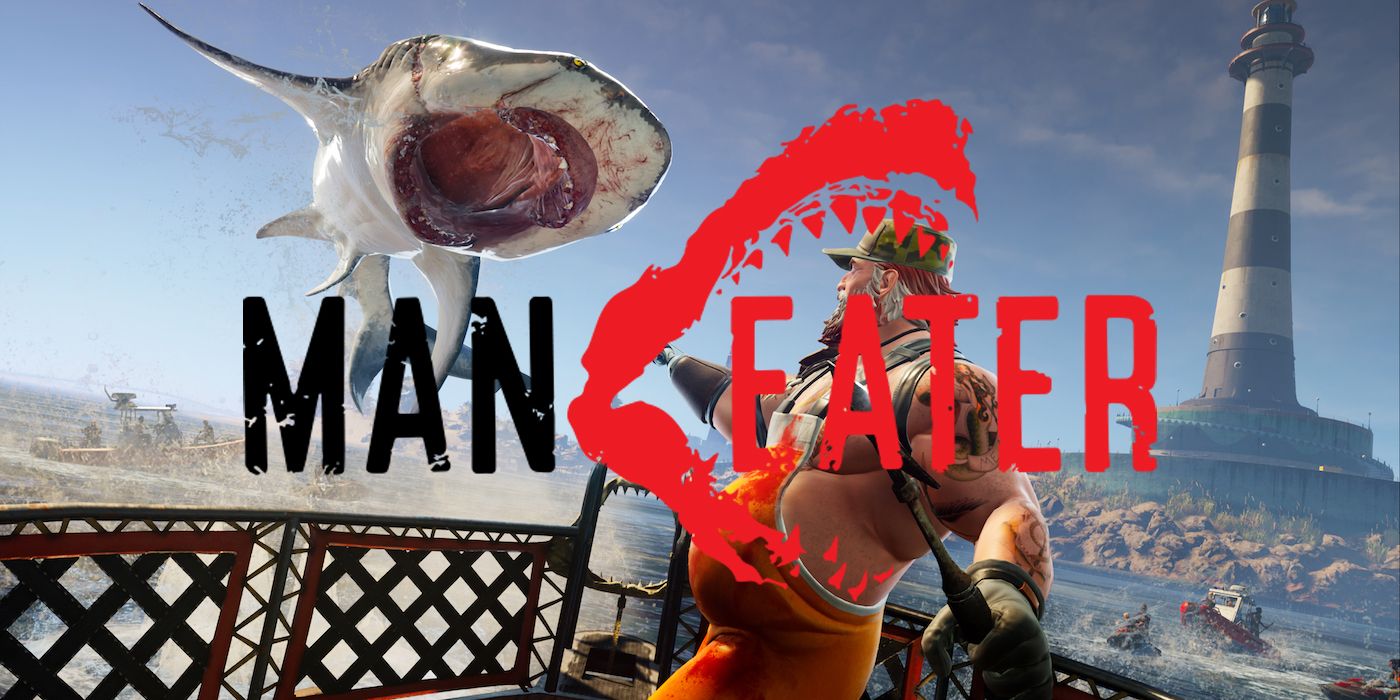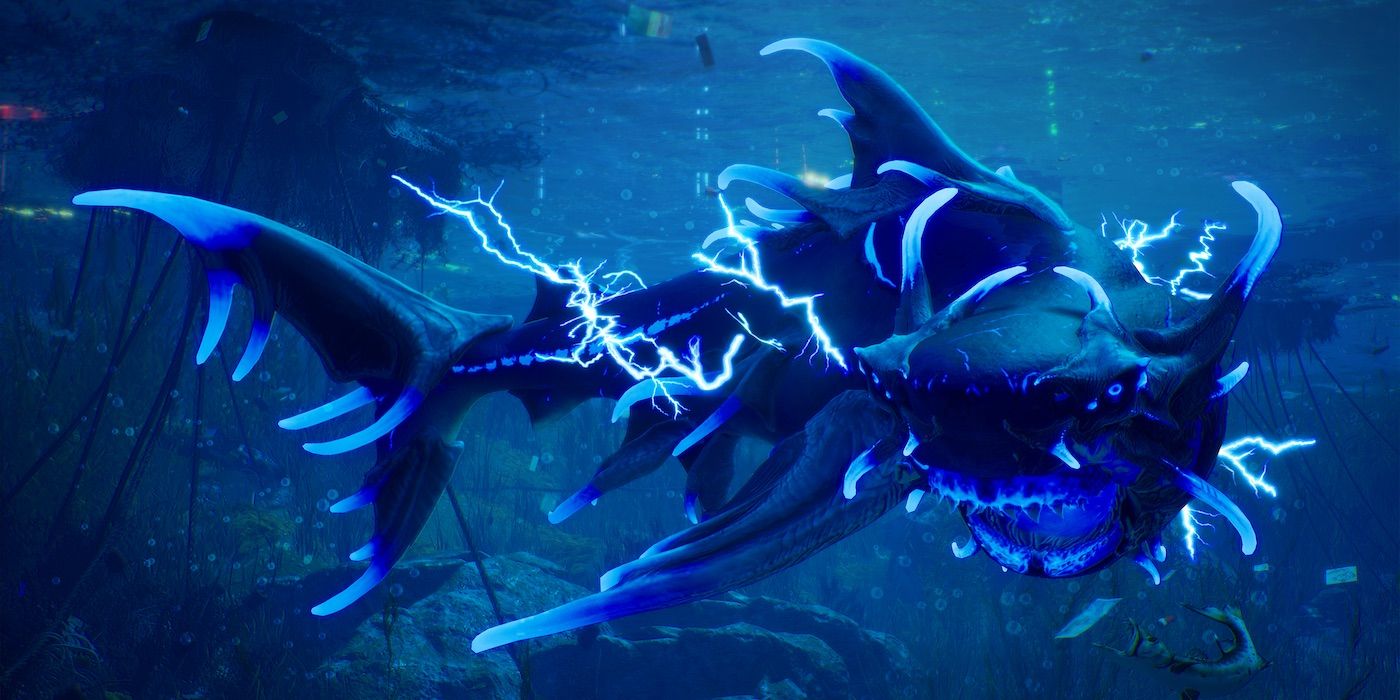In its purest form, Maneater aspires to offer players a little more than they might expect out of a game about a revenge-fueled shark terrorizing a seaside town. Its humor blends well with the concept, the gameplay is deeper than anyone would assume, and it has some very eye-catching moments. But while the setup and the initial pitch of a shark RPG mixed with some Far Cry are exciting, the execution feels lacking and the content quickly starts to run thin.
Maneater follows a familiar format of open-world games. There are several zones within the playable area that players will explore/unlock as they progress through the story. Each zone has a different theme – like a coastal resort, Venetian-esque town, or an open gulf – that is peppered with different sea creatures, humans, and a lot of collectibles. Players can completely ignore most of these items in each zone and focus only on the core missions, but they are key to leveling up and upgrading the shark.
The core of the game is fairly standard for an open world game as well – players enter a new zone like Dead Horse Lake, unlock a fast travel hub in the form of a grotto, travel to new mission icons, complete the missions, and progress to the next zone. Every so often there is a cutscene to propel the story forward and there are some boss fights, but it is this pattern from beginning to end.
What helps break up the monotony of Maneater is its combat and customization/upgrade system. Developer Tripwire Interactive toes the line between realistic and absurd, ensuring that the gameplay is fun but it is never truly limiting. Players can chomp down on unsuspecting fish and sea creatures for health and resources (used as currency for upgrading), but when a more imposing creature is in their way or tries to assert dominance it becomes an underwater (or occasionally above water or land) battle.
Combat in Maneater features a few different options for the shark. She moves as one would expect and there are a basic bite and lunge at player's disposal. But players can supplement those with an evade move, a tail whip, and eventually an "active" attack that serves as a type of super. At first it might seem like all players need to do is swim up to an enemy and hammer on the bite attack, but that strategy doesn’t fully take advantage of what the game has to offer. And as the shark encounters stronger enemies like elite divers, Mako sharks, and orca whales they will need to be a lot more considered about their approach.
Maneater also has an upgrade system for the shark that is basically the game’s version of armor. Players can equip and upgrade (read: buff the bonuses) different pieces of “gear” on her tail, body, fins, teeth, and head that will offer different abilities, passive buffs, and enhancements. These evolutions for the shark can favor different playstyles and enemy types, so it’s fun to mix and match them depending on the situation. The shark upgrades also a lot more than just “the shark can bite harder,” and offer some outlandish abilities like sending out electricity on evade or throwing poison with a tail whip.
The game’s biggest strength is the way it shows tangible growth for the shark. As she increases in size and gains new abilities, the enemies and creatures that were ordeals early on become chum as players progress. The size comparisons also show that progress, as the fish that were once closer in size to the shark eventually become small specks in the ocean.
Finding different ways to utilize the combat and seeing how deep the upgrade path goes are the most appealing parts of the game, but there is not enough to the gameplay to keep things from feeling repetitive. The game’s missions (if one could even call them that) are wholly disappointing and basically boils down to traveling to an area in a zone, killing a specified number of a sea creature/human, and then moving to the next mission. They may be the core to the game's loop but they feel like side missions masquerading as essential content. After completing all of the missions in a zone, a boss fight will trigger but most of those involve fighting stronger versions of existing predators. Fighting a level 8 alligator isn’t all that different than fighting a level 15 alligator, save for the fact its attacks are stronger.
Occasionally, though, the game does dip back into its story, which is outlandish and violent if a bit predictable. A shark hunter named Scaly Pete kills the playable shark’s mother at the outset of the game and she is now set on revenge. Pete meanwhile is still after a Mega size shark to add to his kill record, which puts the young pup on a collision course with the hunter as it starts to grow larger and larger.
As the backdrop for this adventure, the story is razor thin and the cutscenes, dialogue, and action are passable but rough around the edges. Texture pop in can sometimes make character models look odd and most of the interactions between the human characters – which is mostly just Scaly Pete and his son Kyle – are predictable and exaggerated. Maneater has that goofy sense of humor but it doesn’t forgive a subpar presentation.
However, the framing device for the game, which imagines a reality documentary show called Maneater is following the shark and Pete adds a lot of whimsy to the game. Tripwire also enlisted Chris Parnell (Saturday Night Live, Rick and Morty) to narrate a lot of the action, which helps establish a less-than-serious tone filled with fun easter eggs to existing pop culture properties. It actually makes seeking out some of Maneater's collectibles worth the effort just to hear more of Parnell.
Outside of those few story bits and Parnell’s narration, Maneater struggles to propel players forward. A lot of the fun in the game depends on what players put into the experience. If they choose to explore, focus on collecting new gear and upgrading, and seek out collectibles they will find it more engaging than those who stick to the critical path. Even then, the game only takes about 10 hours to complete everything 100%.
This also won’t apply to everyone, but performance on the PS4 Pro is inconsistent the whole way through. Depending on what is happening on-screen, the frame rate can dip significantly, to the point that it becomes hard to make sense of the action. It’s not a game that runs well on the Sony platform and it even crashed a few times while struggling to transition zones.
Playing as a giant shark indulges the fantasy of films like Jaws or The Meg, but there isn’t a lot about Maneater that elevates it above its initial pitch. Besides Parnell’s narration, everything else in the game becomes repetitive faster than players would hope. The environments are cool to look at, but players don’t spend much time in them. It’s almost as if the game considers collectible hunting a part of the core gameplay rather than an optional bonus.
At $40, plenty will find Maneater provides the silly escapism that many are looking for right now. It has the humor and the charm, and it truly indulges the concept of a massive shark terrorizing the land and sea. But a disappointing mission structure, performance struggles on console, and a lack of variety keep the game from being a breakout hit.
Maneater is available now for PC, PS4, and Xbox One. Game Rant was provided a PS4 code for this review.


